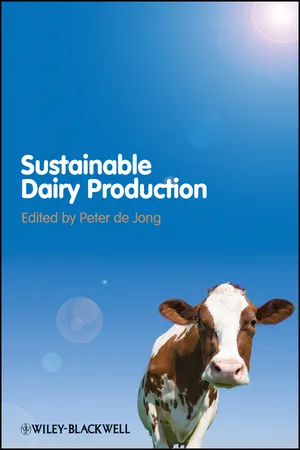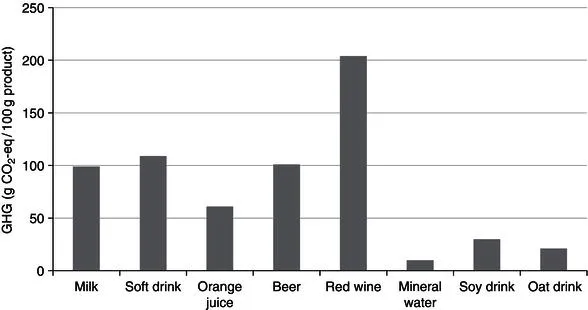
- English
- ePUB (mobile friendly)
- Available on iOS & Android
eBook - ePub
Sustainable Dairy Production
About this book
This book offers a comprehensive overview of the state of the art in sustainable dairy production, helping the industry to develop more sustainable dairy products, through new technologies, implementing life cycle analysis, and upgrading and optimization of their current production lines. It aims to stimulate process innovations, taking into account environmental, economic and public relations benefits for companies. Topics covered include:
- How to set up a sustainable production line
- How to quantify the carbon foot print of a dairy product by using life cycle analysis
- Current technologies to improve the carbon foot print
- What measures can be taken to reduce the global warming potential of the farm
- Reduction of water use in dairy production
- Marketing sustainable dairy products
- Bench marking of dairy products against other food products
- Potential future technological developments to improve the carbon foot print for the following decades
Frequently asked questions
Yes, you can cancel anytime from the Subscription tab in your account settings on the Perlego website. Your subscription will stay active until the end of your current billing period. Learn how to cancel your subscription.
At the moment all of our mobile-responsive ePub books are available to download via the app. Most of our PDFs are also available to download and we're working on making the final remaining ones downloadable now. Learn more here.
Perlego offers two plans: Essential and Complete
- Essential is ideal for learners and professionals who enjoy exploring a wide range of subjects. Access the Essential Library with 800,000+ trusted titles and best-sellers across business, personal growth, and the humanities. Includes unlimited reading time and Standard Read Aloud voice.
- Complete: Perfect for advanced learners and researchers needing full, unrestricted access. Unlock 1.4M+ books across hundreds of subjects, including academic and specialized titles. The Complete Plan also includes advanced features like Premium Read Aloud and Research Assistant.
We are an online textbook subscription service, where you can get access to an entire online library for less than the price of a single book per month. With over 1 million books across 1000+ topics, we’ve got you covered! Learn more here.
Look out for the read-aloud symbol on your next book to see if you can listen to it. The read-aloud tool reads text aloud for you, highlighting the text as it is being read. You can pause it, speed it up and slow it down. Learn more here.
Yes! You can use the Perlego app on both iOS or Android devices to read anytime, anywhere — even offline. Perfect for commutes or when you’re on the go.
Please note we cannot support devices running on iOS 13 and Android 7 or earlier. Learn more about using the app.
Please note we cannot support devices running on iOS 13 and Android 7 or earlier. Learn more about using the app.
Yes, you can access Sustainable Dairy Production by Peter de Jong in PDF and/or ePUB format, as well as other popular books in Technology & Engineering & Food Science. We have over one million books available in our catalogue for you to explore.
Information
1
Introduction
Abstract: Sustainability is sure to be a major topic in the dairy industry in the years to come. More needs to be invested in new technologies and production chains that result in lower energy consumption and more effective use of milk sources. The reason is not primarily because society seeks a lower carbon footprint for dairy products, but simply because of the scarcity of raw materials. It has been shown that dairy products have a relatively high nutrient density, but also a high environmental impact. It is therefore worthwhile to explore the possibilities for a (much) more sustainable dairy chain, which will help with food scarcity problems in the near future. This book is intended to inspire all those who share this aim. Various points of views are discussed: dairy business and marketing, environmental impact, farmers and supply chains.
Keywords: communication, nutrient density, resource scarcity, sustainability hype
1.1 Sustainability and the dairy industry: hype or trend?
Some trends cannot be ignored. The global population is steadily growing and an increasing number of mouths need wholesome food in order to stay alive, including our children. It is clear that this situation demands timely and dedicated action from politicians and captains of industry to tackle future resource scarcity. However, such trends are often accompanied by intensive publicity or hype which overestimates the impact of the trend, be it the increasing population or the future shortage of energy resources and drinking water. This hype makes it difficult to define a clear road map for the future. Should we, for example, introduce carbon footprint labelling on food products, or should we be investing heavily in renewable energy, or should we do everything together at the same time?
Up till now, politicians have tried to clarify the impact of population growth and limited resources through detailed analysis. In 2006 the European Commission published a report on the relative impact of products on the environment throughout their life cycle. It was concluded that food and drink are responsible for 20 to 30% of the environmental impact, in which meat and dairy products are most important (European Commission, 2006). A number of studies followed, including from the United States (US Dairy, 2010). National governments have taken the step of setting targets for food companies to reduce energy use and to reduce greenhouse gas emissions. Companies are increasingly obliged to report their use of resources and to agree on reduction targets over a period of 10 years or longer (Government of Australia, 2008; Agentschap NL, 2010).
Since about 2000, a number of food companies have included green annual reports as an addendum to their conventional main annual reports. Such reports were used to communicate companies’ good intentions to government, nongovernmental organisations and interested consumers. The main achievements in improving energy efficiency were obtained through closing less-efficient factories and upscaling production (Ramírez-Ramírez, 2006). Nowadays, sustainability has become one of the major messages communicated by a food company and is to be found on the home page of their websites. Companies and branch organisations are transparent about their sustainability goals although it is not entirely clear how sound these goals are and how and when they will be achieved. Here are some examples of food companies’ sustainability goals:
- ‘Halve environmental footprint of our products and source 100% of agricultural raw materials sustainably.’ (Unilever, 2011)1
- ‘CO2 neutral in 2020 and global number one through partnerships.’ (Danone, 2010)2
- ‘In 2020 40% of energy used on dairy farms from renewable source, 30% reduction of water use, 50% recycled packaging material.’ (Dairy UK, 2008)3
Figure 1.1 Scarcity means that sustainability must be on the agenda.

In conclusion, it is a clear trend that sustainability will be on the agenda of the worldwide dairy sector for the coming decades. As shown by the simplified scheme in Figure 1.1, scarcity of resources demands more sustainable dairy production.
1.2 Quantifying the issue: measuring footprints
Manufacturers of food products are looking for quantitative measures to control the environmental impact of their products. This is not an easy task. A common measure is the carbon footprint, the equivalent of carbon dioxide (CO2-eq) emission per product quantity. Although the calculation in itself is rather simple, the number of factors influencing the carbon footprint is enormous. In the case of dairy, a number of these factors are not known or differ from farm to farm and even from cow to cow. For example, in the United States a recent study showed that farm management, farm size, farm location and forage level accounted for an almost 50% variation in the final footprint (Rotz et al., 2010). This is probably the reason for the large variation in the reported carbon footprint of pasteurised milk. Table 1.1 lists some reported carbon footprints of milk.
This all stresses the need for standardisation and generalisation. The International Dairy Federation, for example, has published a common approach to quantify the carbon footprint for dairy (IDF, 2010). This is a first step towards a standardised measure of carbon footprint for the dairy sector, addressing conversion factors and allocation factors of co-products during manufacturing.
Table 1.1 Reported carbon footprints of milk (cradle to consumption). Boundary conditions vary between references.
| Reference | kg CO2-eq per kg milk | Comments |
| Carlsson-Kanyama et al., 2003 | 0.3–0.5 | 5 MJ/kg |
| Sevenster & de Jong, 2008 | 0.9–1.8 | Based on literature search in 10 countries (Europe, US, Canada, Oceania) |
| IDF, 2009 | 1.2 | |
| Smedman et al., 2010 | 1.0 | Sweden |
| FAO report: Gerber et al., 2010 | 1.3–7.5 | North America–Africa, global average: 2.4 |
| US Dairy, 2011 | 1.8–2.5 | United States, average 2.1 |
Figure 1.2 Carbon footprint of several beverages expressed as greenhouse gas (CO2-eq) per 100 grams of product. Adapted from Smedman et al. (2010).

1.3 Communication: telling the whole story
In the discussion of the sustainability of dairy products, several benchmarks have been produced. For example, the carbon footprint of milk has been compared with a number of other beverages such as fruit juices, water and soya milk, as shown in Figure 1.2. Mineral water turns out to be by far the most sustainable choice. However, this is definitely not the whole story! If someone was to consume mineral water only, they would probably die within a month. This leads to the conclusion that labelling of food products with a high focus only on their carbon footprint can be misleading.
Smedman et al. (2010) made a first attempt to relate the climate impact of food products to their nutrient density. They defined a so-called Nutrient Density to Climate Impact (NDCI) index:

Assuming that a human being needs a certain amount of nutrients to stay alive, the environmental impact is minimal when a person eats food with a high NDCI value. When NDCI is calculated for the products in Figure 1.2, another choice than mineral water becomes sustainable ( Figure 1.3). Unsurprisingly, milk has the highest NDCI value. In other words, people who drink milk to obtain their daily intake of nutrients and calories have a low impact on greenhouse gases. From this point of view, dairy products are already among the top sustainable food products.
Figure 1.3 Nutrient density of beverages related to climate impact. Adapted from Smedman et al. (2010).

1.4 Structure of this book
This book gives an overview of the main aspects of a sustainable dairy production chain. It follows more or less the approach a dairy company can apply to upgrade their degree of sustainability in terms of energy use, carbon footprint and water footprint. At the end some examples of real...
Table of contents
- Cover
- Title page
- Copyright page
- Dedication
- Preface
- Contributors
- 1 Introduction
- 2 Greenhouse gas emissions from global dairy production
- 3 Life cycle assessment
- 4 Sustainability and resilience of the dairy sector in a changing world: a farm economic and EU perspective
- 5 Dairy processing
- 6 The role of packaging in a sustainable dairy chain
- 7 The business case for sustainable dairy products
- 8 A case study of marketing sustainability
- 9 Cradle to Cradle for innovations in the dairy industry
- 10 The future of sustainable dairy production
- Index